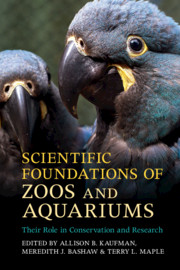Book contents
- Scientific Foundations of Zoos and Aquariums
- Scientific Foundations of Zoos and Aquariums
- Copyright page
- In Memoriam
- Epigraph
- Contents
- Contributors
- Acknowledgments
- Introduction
- Part I Programs and Initiatives
- Part II Captive Care and Management
- Part III Saving Species
- 12 Fly Away Home
- 13 Back into European Wildlife
- 14 The Thin Green Line
- 15 Condor Conservation Comes Home to Roost
- 16 Saving the Black-Footed Ferret from Extinction
- Part IV Basic Research
- Conclusion
- Appendix
- Index
- References
15 - Condor Conservation Comes Home to Roost
The Santa Barbara Zoo’s Story
from Part III - Saving Species
Published online by Cambridge University Press: 21 December 2018
- Scientific Foundations of Zoos and Aquariums
- Scientific Foundations of Zoos and Aquariums
- Copyright page
- In Memoriam
- Epigraph
- Contents
- Contributors
- Acknowledgments
- Introduction
- Part I Programs and Initiatives
- Part II Captive Care and Management
- Part III Saving Species
- 12 Fly Away Home
- 13 Back into European Wildlife
- 14 The Thin Green Line
- 15 Condor Conservation Comes Home to Roost
- 16 Saving the Black-Footed Ferret from Extinction
- Part IV Basic Research
- Conclusion
- Appendix
- Index
- References
Summary
- Type
- Chapter
- Information
- Scientific Foundations of Zoos and AquariumsTheir Role in Conservation and Research, pp. 400 - 439Publisher: Cambridge University PressPrint publication year: 2019



